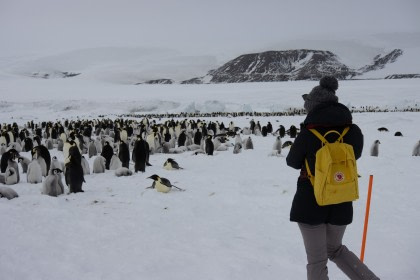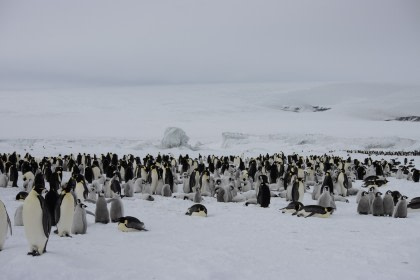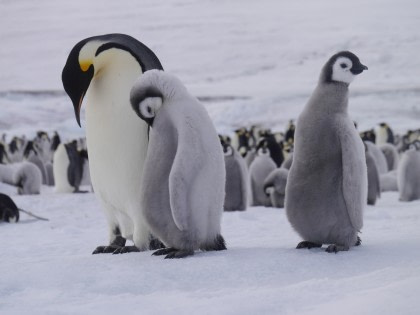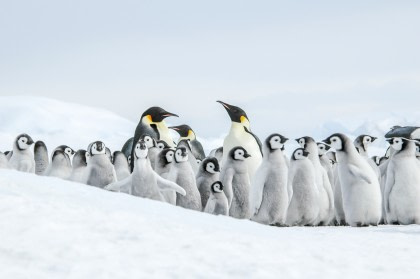Encounter with the emperor penguin in Antarctica
Dutch journalist Gemma Venhuizen embarked on the MV Ortelius during the Weddell Sea cruise 'In search of the emperor penguins'. She had several encounters with this majestic penguin species - both from the sea and from the air.

Picture yourself in a white, frozen world. No trees, no buildings - no sunlight even, during the Antarctic winter months. Only the moon and the stars diminish the darkness in the polar night. Welcome to the empire of the emperor penguin. With a height up till 1,23 meter and a weight up till 40 kilograms, the emperor is much taller than chinstrap, gentoo, Adélie and other penguin species. His plumage adds up to his royal appearance: the solemn black and white tuxedo is accompanied by a colourful tie - his throat has a beautiful, orange-yellowish hue.
Kneeling for the emperor
The first time I found myself eye in eye with an emperor penguin, was during a trip with Oceanwide Expeditions, at the break of Antarctic summer - December 1st, also known as International Antarctica Day. We had just embarked the Zodiacs for a small cruise. The Ortelius was towering above us.
As we came nearer to the ice edge, we noticed this lonely figure, standing solemn and upright. I heard the sound of camera shutters, of bag zippers - people around me where reaching for their binoculars and long-focus lenses. I had neither of them, so I was just staring - almost feeling like a voyeur. The emperor seemed to stare back, and I crouched a bit: kneeling, as far as possible in a small rubber boat, seemed the only logical thing to do.
True Antarctic species
Of the seventeen penguin species around the world, there are only two 'true' Antarctic ones: the Adélies and the emperor penguins, that live and breed on the Antarctic continent. Admittedly, some other species - gentoo, chinstrap and macaroni penguins - breed on the most northern tip of the Antarctic peninsula, but they don't venture as far southward as the emperors and Adélies do. Moreover, the emperor penguins are the only penguins that breed during wintertime, on the sea ice. Therefore, climate change is a huge danger to them. A WWF study from 2008 estimated that approximately 50 percent of the emperor penguins will disappear if global average temperature rises by 2 degrees Celsius - yet another reason to fight global warming.

Fluffy chicks
As I was crouching in the zodiac, only metres away from this unique bird, I knew there was a penguin crèche nearby. A few kilometres from us, at this exact moment, there would be a hustle and bustle of thousands of grown-up emperors and fluffy chicks. Flapping, stumbling and squealing their way around the colony - the real life version of the movie Happy Feet. Not knowing what their parents had to endure during the previous months. I thought of another movie I had seen previous to my visit to the Antarctic: March of the Penguins, about the epic journey that emperor parents undertake in order to care for their unborn child. Emperor penguins are the least common Antarctic penguin: there are only around 200,000 breeding pairs.

-60 degrees Celsius
In May, at the beginning of Antarctic winter, the female lays a single egg. She then passes it over to her partner, who will breed for it for nine weeks, during the coldest time of the year. Temperatures might reach -60 degrees Celsius, accompanied by wind gusts over 180 km/hour. The female will march over 100 kilometres, to the ice edge, where she can fill her stomach with crustaceans, squid and small fish. Emperors can dive deeper and longer than any other bird: they can dive over 200 metres deep, for a period of 18 minutes. During this period, the male fasts; his body weight is reduced by almost 50 percent. When the female returns, it's time for the male to go on his quest for food.
All this time, the egg is kept warm by the parent that is on duty. The penguins cover the egg with their body to shield it from the cold. The egg is lying on their feet. According to the website of the British Antarctic Survey, the egg can be 70°C warmer than the outside temperature, due to the thick layer of skin and the dense feathers - about 280 feathers per square centimetre.
Helicopter flight
No matter how impressive the march of the emperor penguins is, it still looks a bit clumsy: a wiggling penguin is adorable. The emperor penguin that we encountered during our zodiac cruise, however, chose another way of transport. We saw him sliding on his belly towards the ice edge - and that surely was an impressive sight. He used his wings as paddles, and his feet as 'engine'. This way of transportation surely was very effective: in no time, he appeared out of sight. Meanwhile, our zodiac was surrounded by drift ice and we had to return to the Ortelius immediately to prevent getting stuck in the ice. Back on board, the crew had a surprise for us: we would make a helicopter flight over the nearby emperor penguin colony at Snow Hill Island.
Hopefully, there won't be too many skuas around in the colony. They are the mortal enemies of emperor penguin chicks. Penguin parents who lose their child, sometimes kidnap a chick from a neighbouring couple. Fortunately, the survival rate of emperor penguins is high: 95 percent survives the first year. Unless the sea ice conditions are harsh: in that case, many chicks starve to death. Many emperor penguins wait with mating until they are 6 year old. They can live up to 20 years.

Black and gray dots
We split up in several groups: there were two helicopters on board, one for 4 passengers, one for 5 passengers. Inside, it was cosy and noisy - luckily, we had ear protectors on. The Chilean pilot smiled at us and then we took off. I was enjoying the scenery so much, that I almost forgot the purpose of the trip. Then, however, one of my friends pointed at thousands of black specs beneath us. This time, I was better prepared than in the Zodiac: I had my binoculars with me. And indeed, right below the helicopter was a huge colony of emperor penguins. I could even see smaller gray dots: the emperor chicks. I was cheering so loud that my fellow passengers could here it, even with their ear protection on.






